Sennheiser ew IEM G4, SR IEM G4 Users Manual
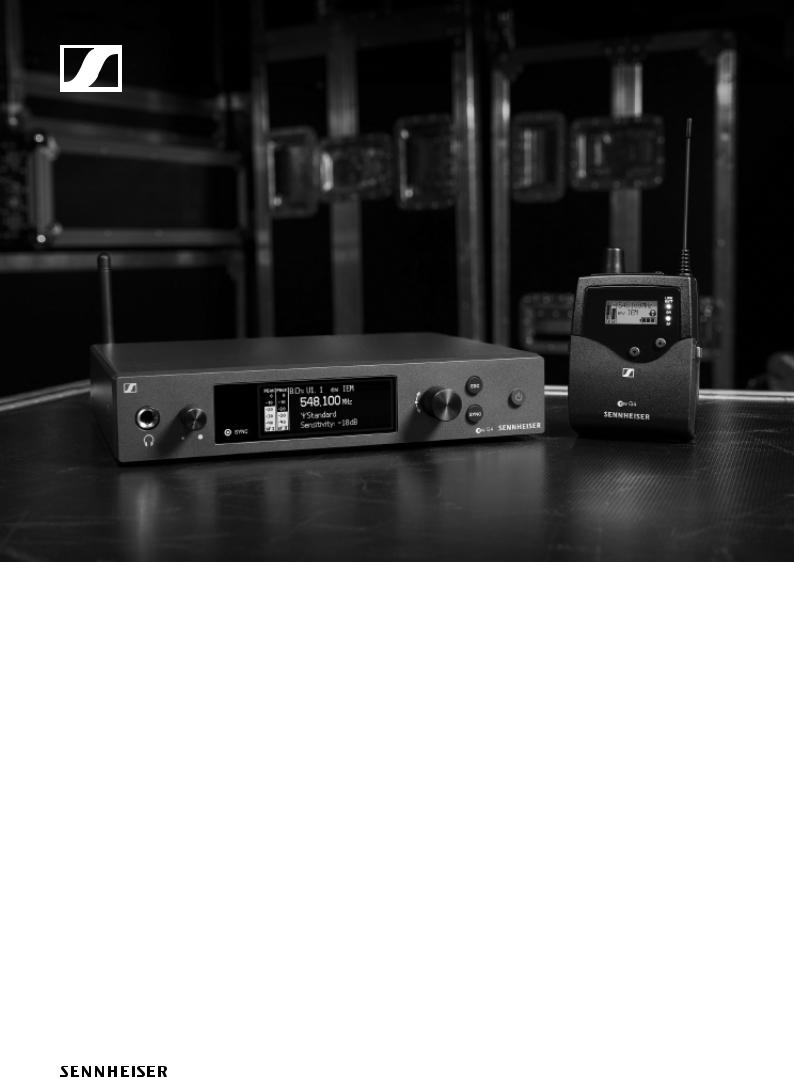
evolution wireless G4 IEM series
Instruction Manual
Sennheiser electronic GmbH & Co. KG
Am Labor 1, 30900 Wedemark, Germany, www.sennheiser.com ew IEM G4 - v2.1

Overview 5
ew IEM G4 series products 6
EK IEM G4 stereo diversity receiver 7 SR IEM G4 stereo transmitter 8
Accessories 9
Earphones 9 IE 40 PRO 9
IE 400 PRO 10
IE 500 PRO 11 IE 4 12
Rechargeable battery and charger 13 BA 2015 rechargeable battery 13 L 2015 charger 13
Accessories for rack mounting 14 GA 3 rack mount kit 14
AM 2 antenna front mounting kit 14 Antennas and accessories 15
Omni-directional antennas 15 Directional antennas 15 Antenna combiner 15 Antenna cables 15
The frequency bank system 16
Installing and starting up ew IEM G4 series devices 17
Installing the EK IEM G4 18
Inserting and removing the batteries/rechargeable batteries 19
Battery status 20
Connecting earphones to the EK IEM G4 21 Attaching the diversity receiver to your clothing 22
Installing the SR IEM G4 23
Connectors on the rear of the device 24 SR IEM G4 rear side product overview 24
Connecting/disconnecting the SR IEM G4 with/from the power supply 25
Creating a data network 26 Connecting audio signals 27
Mono 27
Stereo 28
Daisy chaining audio signals 29 Connecting antennas 30
Installing the SR IEM G4 in a rack 31 Mounting a single transmitter in a rack 32
Mounting two receivers side by side in a rack 34
Installing the AC 41 35
Connectors on the rear of the device 36 Connecting/disconnecting the AC 41 to/from the power supply system 37
Connecting the AC 41 with transmitters 38 Connecting antennas 40
1

Installing the AC 41 in a rack 41
Mounting a single antenna combiner in a rack 42 Mounting two antenna combiners side by side in a rack 43
Using ew IEM G4 series devices 44 Using the EK IEM G4 46
Operating elements of the EK IEM G4 diversity receiver 47
EK IEM G4 product overview 47 Switching the EK IEM G4 on and off 49 Lock-off function 50
Displays on the EK IEM G4 display panel 51 Buttons for navigating through the menu 52 Home screen 54
Frequency/Name standard display 54
Bank/Frequency/Limiter standard display 55 Frequency/High Boost standard display 56
Setting options in the menu 57 Menu structure 58
Squelch menu item 59 Easy Setup menu item 61
Scan New List 61 Current List 61 Reset 62
Performing multi-channel frequency setup 62 Frequency Preset menu item 67
Name menu item 68 Balance menu item 69 Mode menu item 70 High Boost menu item 71 Auto Lock menu item 72 Advanced menu item 73
Advanced -> Tune menu item 74 Only adjusting the frequency 74
Setting the channel and frequency 74 Advanced -> Limiter menu item 75 Advanced -> Volume Boost menu item 76 Advanced -> LCD Contrast menu item 76 Advanced -> Engineer Mode menu item 77
Profiles List 77
Load Profiles 78
Advanced -> Reset menu item 79
Advanced -> Software Revision menu item 79
Using the SR IEM G4 80
Operating elements of the SR IEM G4 transmitter 81 Switching the SR IEM G4 on and off 82
Using the headphone output 83
Configuring the audio channels (mono/stereo) 84 Deactivating the RF signal (RF mute) 85
Lock-off function 86
Displays on the SR IEM G4 display panel 87
2

Buttons for navigating the SR IEM G4 menu 89 Navigating through the menu 89
Making changes in a menu item 89 Setting options in the menu 90 Sensitivity menu item 91
Mode menu item 91 Easy Setup menu item 91
Frequency Preset menu item 92 Name menu item 92
Auto Lock menu item 93 Advanced menu item 94 Advanced > Tune menu item 95
Only adjusting the frequency 95 Setting the channel and frequency 95
Advanced > Sync Settings menu item 96 Advanced > RF Power menu item 96 Advanced > Fullscreen Warnings menu item 97 Advanced > Brightness menu item 97 Advanced > Reset menu item 98
Advanced > IP Address menu item 98 Advanced > Software Revision menu item 98
Establishing a radio link 99
Setting notes 99
Synchronizing devices 100
Easy Setup Sync-function (EK IEM G4 -> SR IEM G4) for a single radio link 100
Easy Setup Sync-function (EK IEM G4 -> SR IEM G4) for multi-channel frequency setup 101
Sync function (SR IEM G4 -> EK IEM G4) 102
Using the AC 41 104
Operating elements on the front of the device 105 Switching the AC 41 on and off 106
Meaning of the LEDs 107
Overview 108 Product variants 109
EK IEM G4 product variants 109 Made in Germany 109 Assembled in the USA 109
SR IEM G4 product variants 110 Made in Germany 110 Assembled in the USA 110
AC 41 product variants 110
Frequency tables 111 Specifications 112
EK IEM G4 113
RF characteristics 113 AF characteristics 114 Overall device 114
SR IEM G4 115
RF characteristics 115
3

AF characteristics 116 Overall device 116
IE 40 PRO earphones 117 IE 400 PRO earphones 117 IE 500 PRO earphones 117 IE 4 earphones 118
AC 41 119 Specifications 119 Block diagram 120
Pin assignment 121
3.5 mm stereo jack plug 121
6.3 mm stereo jack plug, balanced (audio in/loop out)
121
6.3 mm stereo jack plug for headphone jack 121 XLR-3 plug, balanced 121
Hollow jack plug for power supply 121
Cleaning and maintenance 122
4

Overview
PRODUCT INFORMATION
Overview
You can find information about the individual products in the ew IEM G4 series under “ew IEM G4 series products”.
For information about the available accessories, see “Accessories”.
You can find information about the ew IEM G4 series frequency bank system under “The frequency bank system”.
5

ew IEM G4 series products
ew IEM G4 series products
You can also find more information here:
•A variety of frequency variants are available from the individual products. You can find more information under “Product variants”.
•You can find technical specifications about the individual products under “Specifications”.
•You can find information about installing the products under “Installing and starting up ew IEM G4 series devices”.
•You can find information about operating the products under “Using ew IEM G4 series devices”.
6
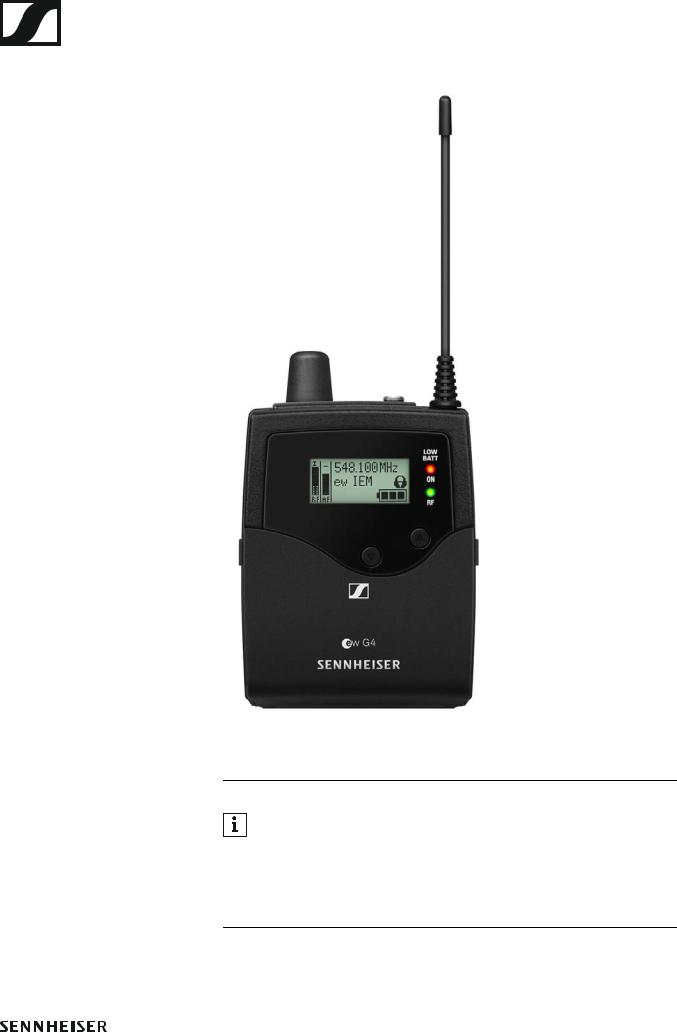
EK IEM G4 stereo diversity receiver
You can find more detailed information about the EK IE MG4 in the following sections:
•Installation and Startup: “Installing the EK IEM G4”
•Operation: “Using the EK IEM G4”
•Technical Data: “EK IEM G4”
7

SR IEM G4 stereo transmitter
You can find more detailed information about the SR IEM G4 in the following sections:
•Installation and Startup: “Installing the SR IEM G4”
•Operation: “Using the SR IEM G4”
•Technical Data: “SR IEM G4”
8

Accessories
Accessories
A variety of accessories are available for the ew IEM G4 series.
Earphones
IE 40 PRO
IE 40 PRO BLACK - cat. no. 507481
IE 40 PRO CLEAR - cat. no. 507482
Technical data: see “IE 40 PRO earphones”
You can find more information about the earphones on their product page at:
www.sennheiser.com/ie-40-pro
9
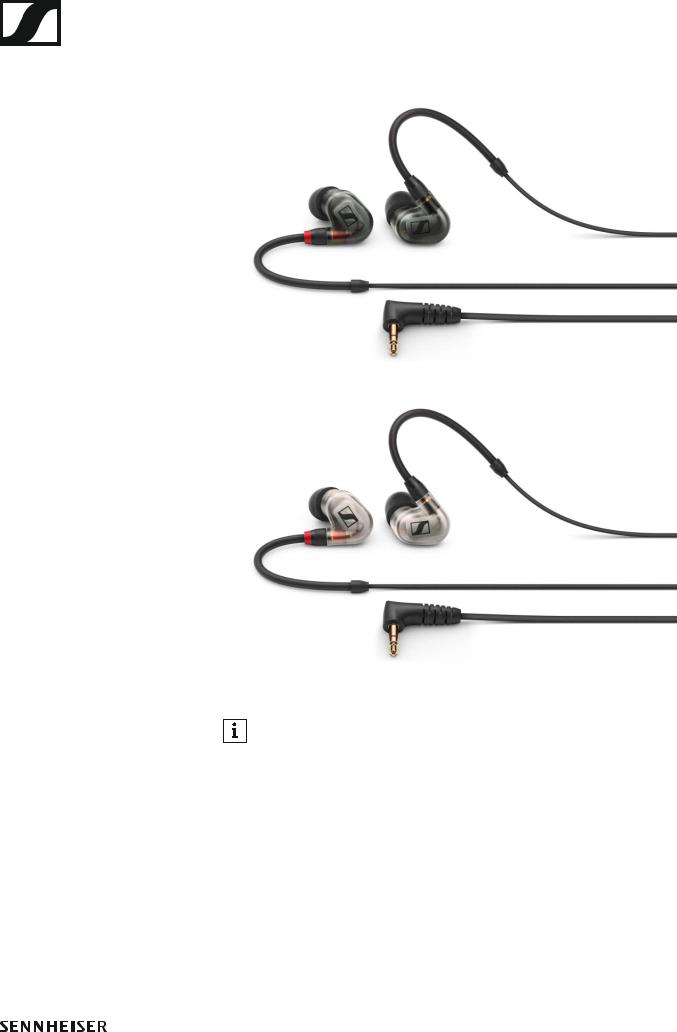
Accessories
IE 400 PRO
IE 400 PRO SMOKY BLACK - cat. no. 507483
IE 400 PRO CLEAR - cat. no. 507484
Technical data: see “IE 400 PRO earphones”
You can find more information about the earphones on their product page at:
www.sennheiser.com/ie-400-pro
10

Accessories
IE 500 PRO
IE 500 PRO SMOKY BLACK - cat. no. 507479
IE 500 PRO CLEAR - cat. no. 507480
Technical data: see “IE 500 PRO earphones”
You can find more information about the earphones on their product page at:
www.sennheiser.com/ie-500-pro
11

Accessories
IE 4
Article no. 500432
Technical data: see “IE 4 earphones”
You can find more information about the earphones on their product page at:
www.sennheiser.com/ie-4
12

Accessories
Rechargeable battery and charger
BA 2015 rechargeable battery
The BA 2015 rechargeable battery is designed for use with evolution wireless G4 series handheld transmitters, bodypack transmitters and bodypack receivers.
Article no. 009950
L 2015 charger
The BA 2015 rechargeable battery can be charged in the L 2015 charger on its own or inside of the bodypack transmitter/bodypack receiver.
Article no. 009828
13

Accessories
Accessories for rack mounting
GA 3 rack mount kit
19” rack adapter for mounting the EM 100 G4, EM 300 G4, EM 500 G4 or SR IEM G4 in a 19” rack.
Article no. 503167
AM 2 antenna front mounting kit
Antenna front mounting kit for installing antenna connections on the front of the rack when using the EM 100 G4, EM 300 G4, EM 500 G4 or SR IEM G4 together with the GA 3 rack mounting kit.
Article no. 009912
14
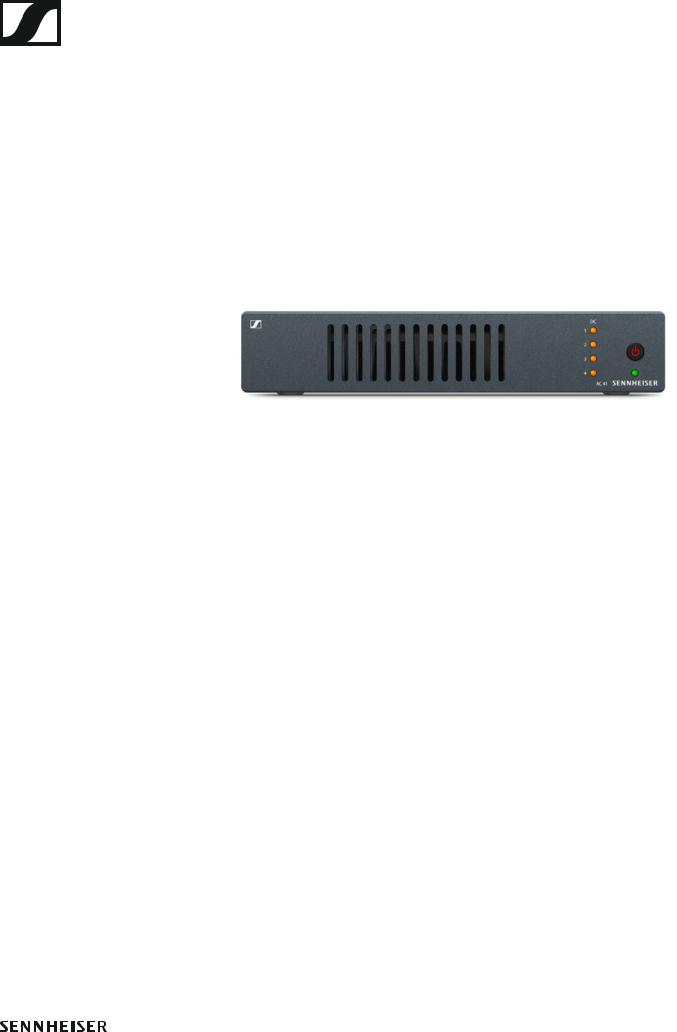
Accessories
Antennas and accessories
The following antenna components are available as accessory parts.
Omni-directional antennas
•A 1031-U, passive omni-directional antenna, article no. 004645
Directional antennas
•A 2003 UHF, passive directional antenna, article no. 003658
Antenna combiner
•AC 41, active antenna combiner
•ASA 41-EU, 470 – 870 MHz, article no. 508243
•AC 41-UK, 470 – 870 MHz, article no. 508295
•AC 41-US, 470 – 608 MHz, article no. 508244
•See “Installing the AC 41” and “Using the AC 41”
Antenna cables
•GZL 1019, BNC/BNC coaxial cable, antenna cable with 50 ? characteristic (wave) impedance
•GZL 1019-A1 variant, 1 m (3 ft), article no. 002324
•GZL 1019-A5 variant, 5 m (16 ft), article no. 002325
•GZL 1019-A10 variant, 10 m (16 ft), article no. 002326
15

The frequency bank system
The frequency bank system
There are different frequency ranges in the UHF band available for transmission.
The following frequency ranges are available for the ew IEM G4 series:
•A1 range: 470 – 516 MHz
•A range: 516 – 558 MHz
•AS range: 520 – 558 MHz
•G range: 566 – 608 MHz
•GB range: 606 – 648 MHz
•B range: 626 – 668 MHz
•C range: 734 – 776 MHz
•D range: 780 – 822 MHz
•TH range: 794 – 806 MHz
•E range: 823 – 865 MHz
Every frequency range has 26 frequency banks with up to 16 channels:
You can find information about the frequency presets in the frequency tables of the respective frequency ranges under “Frequency tables”.
16
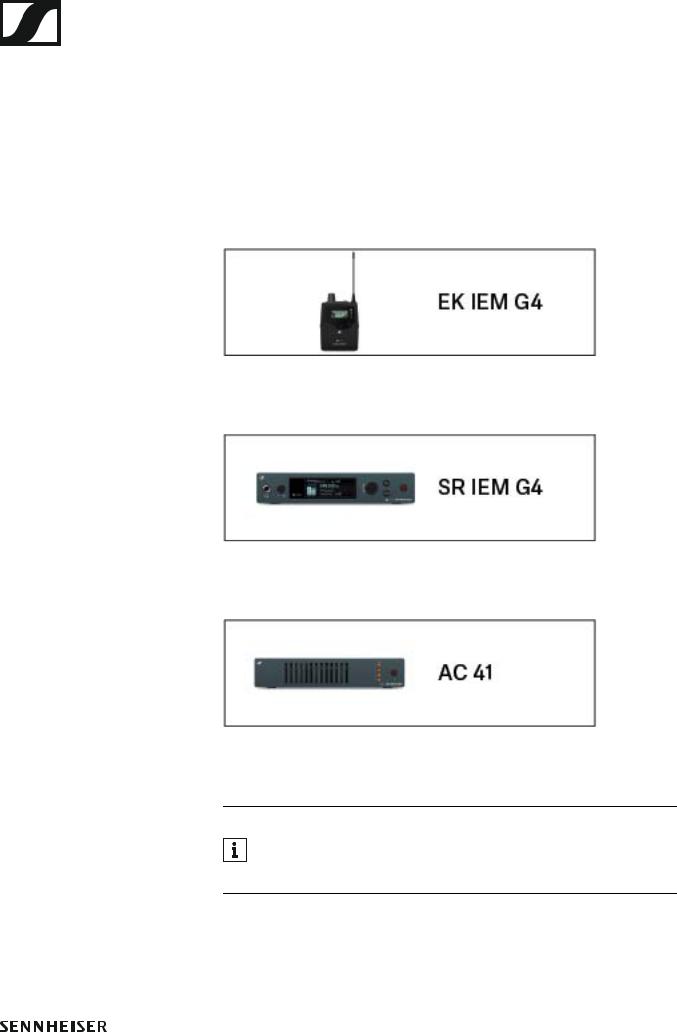
Installing and starting up ew IEM G4 series devices
INSTALLATION
Installing and starting up ew IEM G4 series devices
You can find information about installing and connecting ew IEM G4 series devices in the following sections.
•EK IEM G4 diversity receiver >> “Installing the EK IEM G4”
•SR IEM G4 stereo transmitter >> “Installing the SR IEM G4”
•ASA 214 antenna combiner >> “Installing the AC 41”
You can find information about operating the products under “Using ew IEM G4 series devices”.
17

Installing the EK IEM G4
Installing the EK IEM G4
These sections contain detailed information about installing and starting up the EK IEM G4.
You can find information about operating the EK IEM G4 under “Using the EK IEM G4”.
18

Installing the EK IEM G4
Inserting and removing the batteries/rechargeable batteries
You can operate the diversity receiver either with batteries (AA, 1.5 V) or with the rechargeable Sennheiser BA 2015 battery.
Press the two catches and open the battery compartment cover.
Insert the batteries or the rechargeable battery as shown below. Please observe correct polarity when inserting the batteries.
Close the battery compartment.
The cover locks into place with an audible click.
19
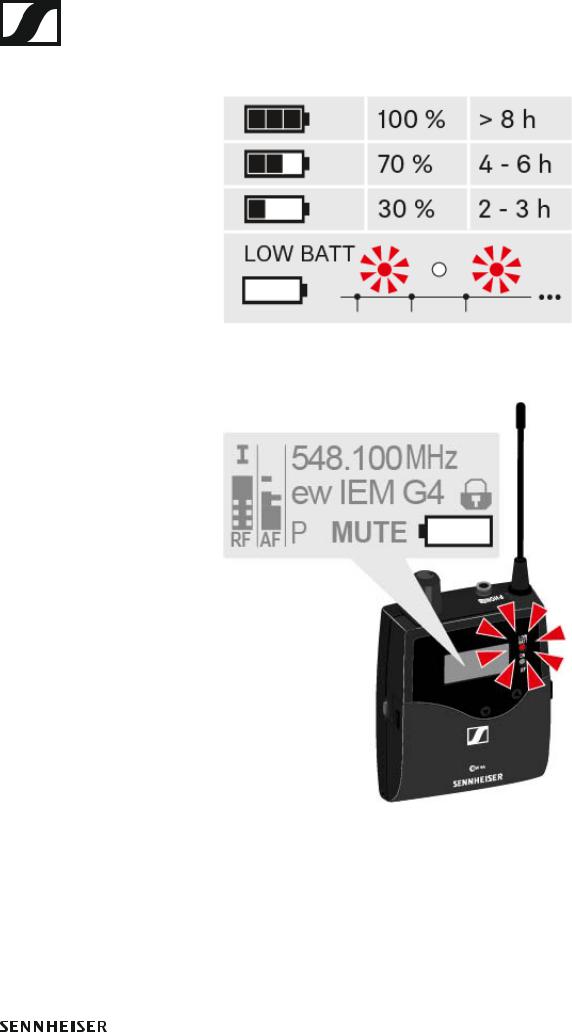
Installing the EK IEM G4
Battery status
Charge status of the batteries:
Charge status is critical (LOW BATT):
20

Installing the EK IEM G4
Connecting earphones to the EK IEM G4
ATTENTION
Danger due to high volume levels
Volume levels that are too high may damage your hearing.
Turn down the volume of the headphone output before you put on the headphone.
To connect the earphones to the receiver:
Insert the cable’s 3.5 mm jack plug into the PHONES socket on the receiver as shown in the diagram.
The ground connection of the earphone cable acts as an antenna for the second diversity branch. For details on the pin assignment, see “Pin assignment”.
21
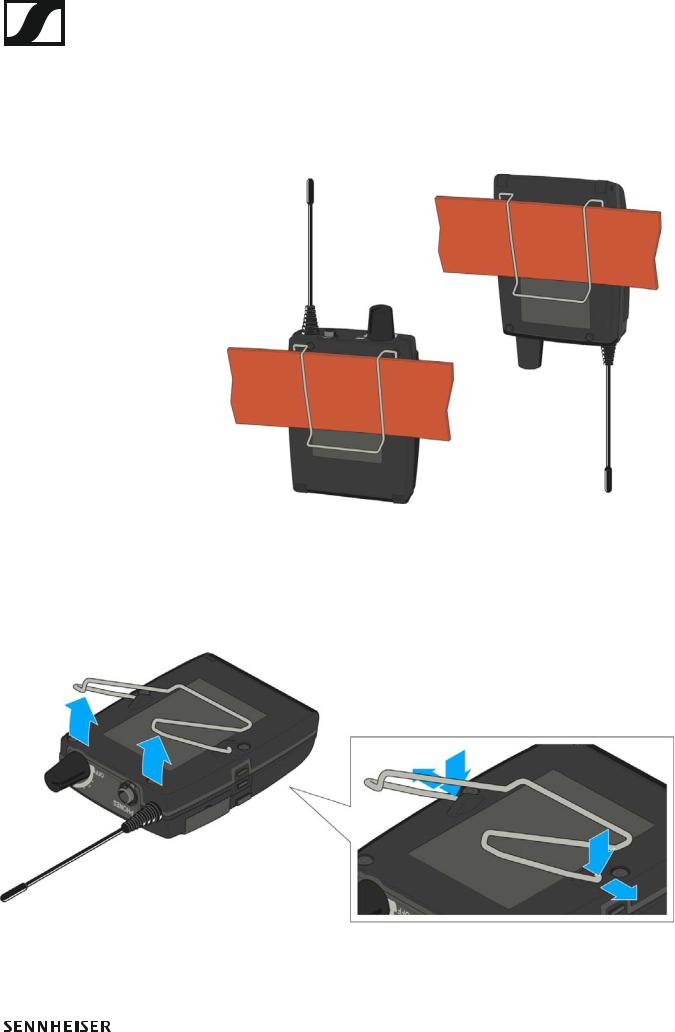
Installing the EK IEM G4
Attaching the diversity receiver to your clothing
You can use the belt clip to attach the diversity receiver to your waistband or on a guitar strap.
The belt clip is detachable so that you can also attach the diversity receiver with the antenna pointing downwards. To do so, withdraw the belt clip from its fixing points and attach it the other way round.
The belt clip is secured so that it cannot slide out of its fixing points accidentally.
To detach the belt clip:
Lift the belt clip as shown in the diagram.
Press one side of the clip downward on the fixing hole and pull it out of the housing.
Do the same thing on the other side.
22

Installing the SR IEM G4
Installing the SR IEM G4
These sections contain detailed information about installing and starting up the SR IEM G4.
You can find information about operating the SR IEM G4 under “Using the SR IEM G4”.
23
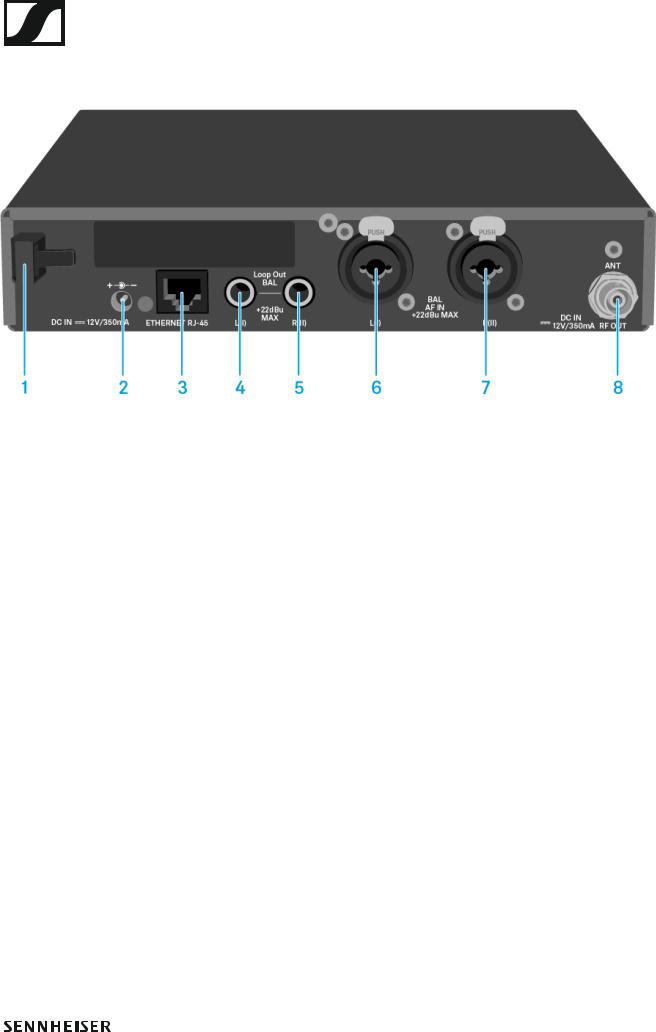
Installing the SR IEM G4
Connectors on the rear of the device
SR IEM G4 rear side product overview
1Strain relief for the cable of the power supply unit
•See “Connecting/disconnecting the SR IEM G4 with/from the power supply”
2DC INsocket
•For connecting the power supply unit
•See “Connecting/disconnecting the SR IEM G4 with/from the power supply”
3LAN connection socket (ETHERNET RJ 45)
•See “Creating a data network”
46.3 mm jack socket LOOP OUT BAL L(I)
•Audio output, left
•See “Daisy chaining audio signals”
56.3 mm jack socket LOOP OUT BAL R(II)
•Audio output, right
•See “Daisy chaining audio signals”
6XLR-3/6.3 mm jack combo socket BAL AF IN L(I)
•Audio input, left
•See “Connecting audio signals”
7XLR-3/6.3 mm jack combo socket BAL AF IN R(II)
•Audio input, right
•See “Connecting audio signals”
8RF OUT BNC socket
•Antenna output with remote power supply input
•See “Connecting antennas”
24

Installing the SR IEM G4
Connecting/disconnecting the SR IEM G4 with/ from the power supply
Only use the supplied power supply unit. It is designed for your receiver and ensures safe operation.
To connect the SR IEM G4 transmitter to the power supply:
Insert the plug of the power supply unit into the DC IN socket of the receiver.
Pass the cable of the power supply unit through the cable grip.
Slide the supplied country adapter onto the power supply unit.
Plug the power supply unit into the wall socket.
To disconnect the SR IEM G4 transmitter from the power supply:
Unplug the power supply unit from the wall socket.
Unplug the power supply unit from the DC IN socket of the receiver.
25
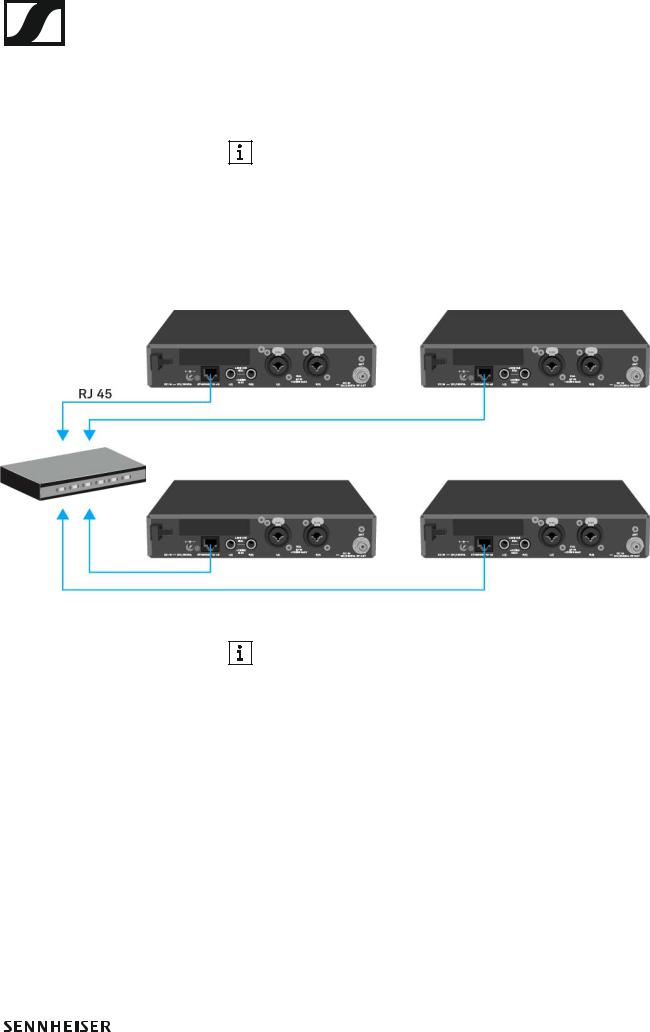
Installing the SR IEM G4
Creating a data network
You can monitor and control one or more SR IEM G4s via a network connection using Sennheiser Wireless Systems Manager (WSM) software.
Automatic frequency setup can also be performed over the network without the WSM software. See “Easy Setup menu item”.
To connect the SR IEM G4 to a network:
Connect a network cable with an RJ-45 connector (to the Ethernet socket on the rear side of the SR IEM G4.
Connect the other end of the network cable to a network switch.
For more information about controlling devices via the Sennheiser Wireless Systems Manager (WSM) software, refer to the instruction manual for the software. You can download the software here:
www.sennheiser.com/wsm
26

Installing the SR IEM G4
Connecting audio signals
You can connect Mono or Stereo signals via the two input sockets BAL AF IN L(I) and BAL AF IN R(II).
To do so, the SR IEM G4 must be configured for Mono or Stereo operation in the menu. See “Mode menu item”.
In Stereo mode, you can receive the two input signals either as a
mixed mono signal or as a stereo signal. To do so, you must select
Focus or Stereo mode on the EK IEM G4 receiver. See “Mode menu item”.
Mono
Connect the output of an external device (e.g. a mixing console or another SR IEM G4) to the audio input socket BAL AF IN L(I) + MONO using a suitable cable.
In Mono mode, the corresponding EK IEM G4 receiver must be operated in Focus mode. See “Mode menu item”.
27

Installing the SR IEM G4
Stereo
Connect the output of an external device (e.g. a mixing console or another SR IEM G4) to the audio input sockets BAL AF IN L(I) and BAL AF IN R(II) using suitable cables.
In Stereo mode, the corresponding EK IEM G4 receiver can be operated in Focus mode or Stereo mode. See “Mode menu item”.
28

Installing the SR IEM G4
Daisy chaining audio signals
Using the LOOP OUT BAL L and/or LOOP OUT BAL R output sockets, it is possible to transmit a signal that you want to make available to all receivers from the mixing console to a transmitter and then to daisy chain this signal from the transmitter to the other transmitters.
In this way, for example, you can distribute an AUX path from the mixing console in Focus mode to multiple transmitters and output a separate signal on the other channel of the same transmitter (e.g. for the individual musician).
Transmit a signal from the mixing console to the input socket of transmitter A (in this example: BAL AF IN R).
Connect the LOOP OUT BAL R output socket of transmitter A with the BAL AF IN R input socket of transmitter B.
Now connect the LOOP OUT BAL R output socket of transmitter B with the BAL AF IN R input socket of transmitter C.
Continue on in this way for the remaining transmitters.
29
